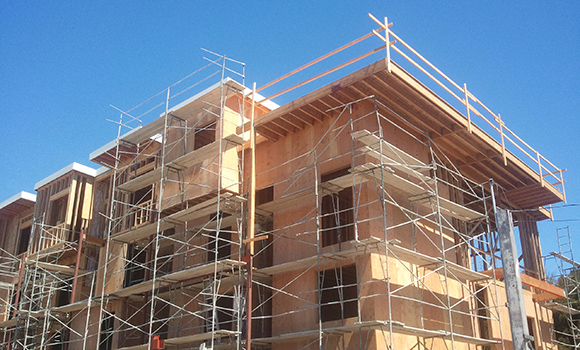
Construction in Oakland, California (Photo Credit: Mike Linksvayer/Flickr)
Over the last several weeks the Governor has placed a high priority on reducing greenhouse gas emissions through the extension of the state’s cap-and-trade program. With the extension likely to be voted on next week, legislative leaders have indicated that the lack of affordable housing in California deserves the same attention. The Speaker of the Assembly and Senate President Pro Tem have notified the Governor that legislation to increase the supply of housing will be essential to meeting the state’s goals for promoting sustainable communities.
This is an opportunity for the Governor and the Legislature to finally bring the housing issue to some conclusion—and to respond to an affordability crisis that is impacting nearly every household in the state. With a vote likely on Monday, we will see if the Legislature can not only extend the cap-and-trade program, but also produce a legislative package that will deal with California’s dire shortage of housing affordable to every income level.
Nearly half of Californians are now struggling to rent or buy a home in their communities—and millions more are unable to live anywhere close to their jobs because of rising costs. The analysis is clear, compelling and consistent: California needs comprehensive action to address what some are now calling a housing “catastrophe.”
In 2016, with considerable stakeholder input, CA Fwd and the California Economic Summit developed an “All of the Above Framework” supported by an extensive analysis from the McKinsey Global Institute documenting the potential for similar policy changes to meaningfully increase the supply and reduce the cost of housing.
Earlier this week, Summit leaders sent policymakers a letter asserting that the roughly 50 housing bills still moving through the Legislature “are not yet sufficient to address the dramatic undersupply of housing, of all kinds, that is at the root of this problem.”
Democrats are said to have linked three bills to the cap-and-trade negotiations: SB 2 (Atkins), a $250 million permanent source of funding for subsidized housing; SB 3 (Beall), a $3 billion housing bond for the same purpose; and SB 35 (Wiener), which would streamline the approval process for infill housing developments in communities that are not meeting their state housing quota, so long as those projects pay prevailing wage and hire “skilled and trained” workers from certified apprenticeship programs.
Last year, the Governor’s proposal to streamline housing approvals in very specific circumstances revealed that he understands the problem is multi-dimensional. He reinforced that in January when he published “principles” for a solution, emphasizing the need to “reduce permit and construction policies that drive up unit costs”—and including an admonition that “any permanent source of funding should be connected to these other reforms.”
The Summit letter this week pointed out that cost containment measures are largely missing from this year’s legislation—including efforts like SB 35, which seeks to accelerate development, but also would likely increase the cost of housing in the relatively few communities that would qualify under the law.
Several options should be on the table, including fiscal incentives for communities to underwrite housing-related infrastructure, a broader definition of the sites that would eligible for streamlined approval, and more clarity on whether these projects would be subject to CEQA litigation delays.
Current legislation does not include any of these important elements. In fact, to win political support, the bills have moved the other way, adding costs by requiring prevailing wage and hiring of “skilled and trained” workers for nearly every qualifying project—without offsetting these new financial burdens in some way.
The Summit’s working group has looked elsewhere for cost containment opportunities, exploring specific ways to address the challenge posed by the growing local fees many communities charge developers to pay for local infrastructure (and that have grown as large as $100,000 per unit in some places).
In some cases—particularly urban infill projects where housing is most desirable from a climate perspective—these costs are preventing permitted projects from getting built. In all cases, they add to the final price, by an average of 15 percent.
We simply must find new ways to pay for basic community services such as sewer and water hookups, local streets and amenities. There was a time when these costs were borne by the community, and returning to that shared commitment may require state incentive funds.
With housing and cap and trade now potentially linked in Capitol conversations, there is an opportunity to finally address these challenges at the root of the state’s housing crisis. We can’t save the planet on the one hand and forsake our communities on the other. We need to preserve both. We will find out next week if our state leaders can do it.
Fred Silva is senior fiscal analyst for CA Fwd.

